Post
/in Before and After, Decking, DIY, Education, Events, Fencing, On the Job, Project testimonials, Redwood, Retaining WallRepair a Fence Right Away Before the Damage Spreads
/in Fencing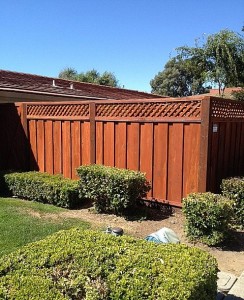 Years of weather and use can wear down even the strongest fence over time. That’s why A & J Fencing not only builds your custom redwood fence from scratch but also specializes in fence repair in Walnut Creek and throughout the Bay Area.
Years of weather and use can wear down even the strongest fence over time. That’s why A & J Fencing not only builds your custom redwood fence from scratch but also specializes in fence repair in Walnut Creek and throughout the Bay Area.
It’s important when repairing a fence to stick with the highest quality materials, like we do with all our fencing and decking projects. We prefer redwood for it’s natural resistance to rot and decay. And just because a section of fencing is bad, it doesn’t mean the whole fence has to be replaced. Just follow our easy fence repair tips.
Fence posts, or any part of the fence that has been buried in the ground, are particularly susceptible rot and decay. Bottom rails and the bottoms of screening can decay if they have been in contact with water or vegetation that helps trap moisture. Always try to keep vegetation clear of your wood fence. Carefully inspect fences at least once a year paying attention to the areas that might be susceptible to rot. When you find a problem, repair the fence right away before damage spreads.
Repairing Fence Posts
Since your fence posts are the foundation of your fence’s structure, obviously it is important to make sure all posts are sound as one rotten post can take down a portion of or an entire fence. First determine if a wobbly fence post is completely rotted. If not it can be splinted or staked instead of replaced. Brace the post by hammering a pair of 2×4’s, one on each side of the post. If the post is loose in the posthole, brace the post by driving stakes into the posthole along the sides of the post to pinch it into place. And if necessary pour concrete around the post’s base for a secure fit. If the post is completely rotten, you will need to dig out the post and concrete base, replace the post and pour a new concrete base.
Repairing Fence Rails
If a rail has come loose from one or more of its posts it may be salvageable. Mend the break by hammering two pieces of 2×4 scrap directly under the damaged rail with galvanized nails or use metal T-braces. If the rail is rotten, replace the entire rail. To do this you’ll need to disassemble the entire section of fence. Cut new rail lengths of 2X4 so they fit tightly against the fence posts. Nail rails into place with angled galvanized nails then replace fence boards. Measure and cut the fence boards to a uniform length. Nail boards to one side of the rails starting at one end. Leave a space equal to a single board width between each. Secure each board to the rails with two galvanized nails at the top and two at the bottom. Nail tops first, then nail the bottoms, pushing the bottom rail into alignment as you go.
Repairing Fence Gates
If a gate looks like it’s sagging or not closing properly, the first thing to do is check for bent hinges. Gate hinges can become bent over time from wear, from the gate’s own weight, or from people leaning or pulling on them. Replace hinges using galvanized steel hardware, Repair holes and re-drill new holes for new screws or carriage bolts.
Contact us for any fence repair needs or if you need advice on repairing your fence on your own. Keep your wood fence in great shape year round by inspecting, cleaning and treating your wood and keeping it free of brush and vegetation. Read our blog post here for tips on how to care for your redwood fence.
Best Time to Schedule Fence Repair Projects is Now
/in Fencing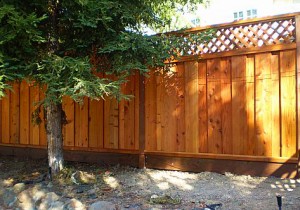 Winter in the San Francisco Bay Area is a great time to schedule a fence repair project. As certified fencing contractors in the East Bay, we are ready to work on your customized fence, repair, or retaining wall projects. One advantage of having fences and retaining walls built during the cold weather season is that it’s easy for us to work quickly without disrupting landowner’s use of the property, as sometimes happens in the warmer months when outdoor areas see more use. Plus, scheduling a fence repair or maintenance project during this time is easier than one might think.
Winter in the San Francisco Bay Area is a great time to schedule a fence repair project. As certified fencing contractors in the East Bay, we are ready to work on your customized fence, repair, or retaining wall projects. One advantage of having fences and retaining walls built during the cold weather season is that it’s easy for us to work quickly without disrupting landowner’s use of the property, as sometimes happens in the warmer months when outdoor areas see more use. Plus, scheduling a fence repair or maintenance project during this time is easier than one might think.
Common Problems Solved by Fence Repair
Even the highest quality fence may eventually need repair. As fences are exposed to the elements year round, wear and tear leads to repair needs, as can less common incidents such as severe storms. However, unsightly damage to fences is typically more easily repaired than looks might suggest. Rather than expensive full fence replacement, repair can cost-effectively target problem areas such as:
- Reinforcing hinges or gate frames
- Replacing missing or broken fence boards
- Repairing loose or rotted fence posts
Most damage to wood, composite, and other types of fencing can be fixed through simple fence repair. In fact, it is fairly rare for a fence that has been regularly maintained to need full replacement after most types of damage, as long as the restoration is done in a timely manner.
Finding Quality East Bay Fence Repair Services
When a fence needs repair, it is best to contact a contractor as soon as possible to fix the damage. This is because certain types of damage, such as wood rot, rust, or sagging fence sections, can spread to the rest of the fence and raise the overall cost of repair. In some cases, such as in storm damage, these repairs may even be covered under insurance.
A & J Fencing handles fence repair projects large and small throughout the Bay Area. A & J Fencing’s experts are equipped and ready to work on all types of fences, including redwood, ornamental, deer, and gate fences. Take a look at our portfolio and contact us at 925-521-6461 for a quote on your fence repair project so that you can have a fully restored and attractive fence by the time spring rolls around.
Redwood You Can Feel Good About – Redwood Timber Third-Party Certification Programs
/in Fencing, Redwood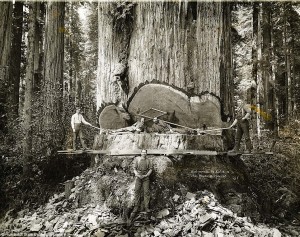 These photos of loggers in the California redwoods of the 1800s are astounding when you consider the giants that small men could bring down. Forests were often felled in clear-cut swaths across hundreds of acres using only manpower, saws and teams of horse or oxen. While breathtaking to see such photos, clearly the results were disastrous for the environment.
These photos of loggers in the California redwoods of the 1800s are astounding when you consider the giants that small men could bring down. Forests were often felled in clear-cut swaths across hundreds of acres using only manpower, saws and teams of horse or oxen. While breathtaking to see such photos, clearly the results were disastrous for the environment.
Today, thankfully, California’s forestry regulations are considered the most stringent in the world. California sets high standards for sustainability and resource conservation. The majority of logging operations undergo third-party certification programs in addition to the mandatory requirements of California’s Forest Practices Act, recognized as the most thorough timber harvesting regulation in North America
Roughly 90 percent of product-producing redwood forests are certified sustainable under the Forest Stewardship Council (FSC) or the Sustainable Forestry Initiative (SFI) programs – the two most widely recognized certification program, according to calredwood.org.
Four of every five acres of commercial redwood forest are now independently certified by either the FSC or the SFI, as well as managed and harvested on a sustainable basis. There are 1.74 million acres of Coastal Redwood forests on California’s north coast. About 26 percent are preserved in national, state, and municipal parks, national monuments and lands where harvesting is prohibited. Of the remaining 1.29 million acres where harvesting can take place, 80 percent are currently being well managed according to the independent third-party certification programs that include FSC and SFI.
Forest certification provides consumers with the assurance that the redwood products they purchase have been harvested in an environmentally sound manner. The basic principles include:
- sustainable forestry
- prompt reforestation
- protection of water quality
- enhancement of wildlife habitat
- minimizing the visual impact of harvesting
- protection of unique sites
- improvements in wood utilization
When you choose redwood, you’re choosing natural wood from sustainable forests. This is important to us at A&J Fencing as we provide redwood fencing and decking to clients throughout the Bay Area. We believe that redwood is the best choice for fences because of its natural resistance to rot and decay and because it is a sustainable California product. Its inherent resistance makes redwood the perfect choice for those who want a naturally beautiful and long-lasting fence.
*Photo is part of the Ericson Collection, a series of pictures from northwest California from the 1880s through the 1920s by Swedish photographer A.W. Ericson.
5 Important Ways to Care for Your Redwood Fence or Deck
/in Decking, Fencing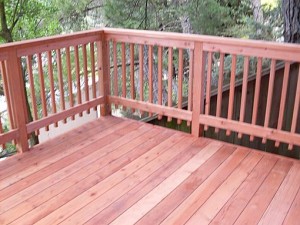 A&J Fencing uses redwood for our projects because it is the best and longest lasting material for a wooden deck or fence. Our redwood is cut thicker than the average fencing wood and we bring it in directly from the mill. Using warm, durable redwood, we build beautiful custom fences as well as decks of any shape and size. But even the best wood fence or deck is susceptible to rot and decay simply because it’s exposed to environmental elements. Here are 5 key ways that you can protect your redwood structure year round.
A&J Fencing uses redwood for our projects because it is the best and longest lasting material for a wooden deck or fence. Our redwood is cut thicker than the average fencing wood and we bring it in directly from the mill. Using warm, durable redwood, we build beautiful custom fences as well as decks of any shape and size. But even the best wood fence or deck is susceptible to rot and decay simply because it’s exposed to environmental elements. Here are 5 key ways that you can protect your redwood structure year round.
- Remove debris and repair. Though a little weathering is often a characteristic that many homeowners find desirable in a redwood fence or deck, before you know it years can go by and your structure has been exposed to environmental elements such a droppings from trees and birds, wind, dirt and rain. First, clean your fence or deck by removing any debris that may have become trapped between the boards. This is best done by using a metal putty knife; don’t use anything sharp like a knife that could knick your boards. Then use a brush or leaf blower to clear any leftover debris.
- Check for any structural damage and repair loose boards. Inspect for loose nails and hammer them back into place and reinforce loose boards with galvanized coated screws. Coated screws won’t rust in wet weather and provide a more durable bond than nails.
- Scrub your fence clean. This step will remove dirt, grease, stains and mildew. Use a stiff fiber brush and wood cleaner to scrub your wood fence or deck. Follow the manufacturer’s instructions on cleaning products. Some common cleaning solutions include a mixture of TSP and water, Simple Green and even household laundry detergent will work. Scrub in the direction of the grain, working with small areas and rinsing clean with water. After scrubbing allow your structure to dry for several days.
- Apply a protective seal. Use a high quality deck stain product, we use Preserva Wood Redwood tinted stain, to enhance the natural color of the redwood. Slightly tinted transparent stains will last longer and protect the deck or fence longer. A high quality product like Preserva Wood with high UV protection and water repellent will give the best results. Use a brush or a roller to apply the stain to your redwood structure. Apply the finish on a cool day without wind, don’t treat your deck in the hot sun. The temperature should be between 50 and 70 degrees. Recommendations vary on how often to stain your deck but we recommend every 3-5 years.
- Keep structure clear of vines and away from sprinklers. You may think that the ivy looks nice crawling up your fence, but the less weight on a fence the better. Vines will keep the wood moist and contribute to it rotting faster. Also keep sprinklers away from your fence or deck as direct contact with water will cause boards to rot and decay much more quickly.
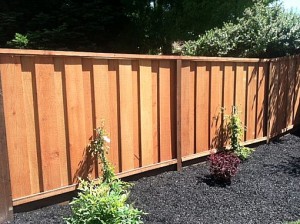
If you don’t want to do it yourself, we’ll do it for you. A&J fencing has a team of specialists on hand to seal and protect your Redwood structure. Just contact us for more information.
Protect Your Yard from Deer with a Deer Fence
/in Fencing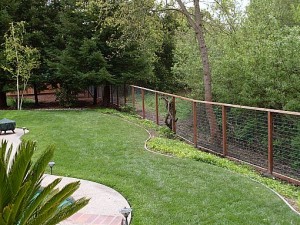 At A & J Fencing, the Bay Area’s premier custom fencing company, we work on creating solutions that best fit your needs and compliment your backyard.
At A & J Fencing, the Bay Area’s premier custom fencing company, we work on creating solutions that best fit your needs and compliment your backyard.
Watching a deer graze outside your kitchen window can be a beautiful sight, that is, unless they are munching through your vegetable garden. At A & J Fencing we want you to be able to enjoy your beautiful yard and maybe still catch a glimpse of a roaming deer or two if you desire. We specialize in attractive deer fencing that will keep the deer out of your garden safely, without blocking your view.
Full-grown deer eat an average of seven pounds of food per day. They prefer a variety and move around nibbling on over 500 different kinds of plants. They do, however, have favorite foods and will search for them even when other foods are abundant. They particularly like the tender new growth found on trees and grasses and in lush gardens. If they find something they like in your yard, you can be sure they’ll be back again and again. Damage to ornamental plants is often the most severe during spring and summer so now is the time to think about putting in a high quality deer fence from A & J Fencing.
There are four different kinds of deer species found in Northern California and six throughout all of California. All six species look similar and have only slight variation in markings and size making it virtually impossible for most people to tell them apart. Deer are “edge” species, which means that they prefer to feed in open areas near cover. Open areas created by humans such as parks and urban yards and gardens provide great places for deer to feed in.
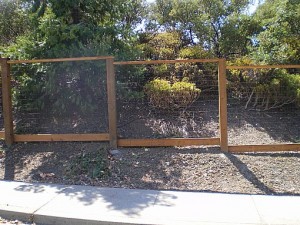 Using the highest quality materials, an A & J deer fence will protect your landscaping for years to come. Our fully framed deer fence uses 4 x 4 inch pressure-treated posts with or without a kick plate and are beautiful to look at. Welded wire 2 x 4 inch galvanized fabric mesh is then pulled tightly and nailed to the posts for strength and durability. This nearly invisible fence is a perfect solution to protecting your garden and preserving your view.
Using the highest quality materials, an A & J deer fence will protect your landscaping for years to come. Our fully framed deer fence uses 4 x 4 inch pressure-treated posts with or without a kick plate and are beautiful to look at. Welded wire 2 x 4 inch galvanized fabric mesh is then pulled tightly and nailed to the posts for strength and durability. This nearly invisible fence is a perfect solution to protecting your garden and preserving your view.





